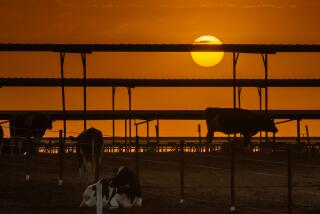No Kidding: Americans Acquiring Taste for Goat
- Share via
STOCKTON — For many Californians, goat has become the other red meat.
Curried goat and birria stew have become fixtures on the menus of local restaurants. Markets catering to Muslims and Latinos do brisk business selling fresh goat meat. Even the meat section of the upscale Whole Foods Market in Glendale now peddles the commodity.
Goat meat imports to the U.S. jumped about 140% over a seven-year period ending in 2003. Now some California farmers see gold in goat. They are expanding their herds, hoping to cash in on consumers’ broadening tastes.
“As goat producers, we are standing in one of the most enviable positions of any agriculture industry in the United States,” said Marvin Shurley, president of the American Meat Goat Assn. in Sonora, Texas. “High demand for our products and livestock prices are unmatched within the history of our industry.”
Some 40% of the goat meat consumed in the U.S. is imported from Australia and New Zealand. The remainder is produced by farmers with herds ranging from 15 to 8,000 animals.
That means the burgeoning goat business is not large enough to mimic the milk industry’s with a “Got Goat?” slogan or to tweak the cheese industry’s marketing campaign: “California: It’s the goat.”
In a recent report, the University of California’s Small Farm Center in Davis said the state was well-positioned to capture a large share of the goat meat market. California’s dry, mild climate favors raising goats. Pasture and leftover farm produce provide excellent feed sources.
In California and across the nation, the fast-growing Muslim, Latino and Asian communities are pushing up the demand for one of the most widely consumed meats in the world. There are about 35 million foreign-born U.S. citizens, and many of those are from goat-eating nations, said Richard Machen, a professor and livestock specialist at Texas A&M; University’s Agricultural Research and Extension Center in Uvalde, Texas.
Many consumers get their fresh goat from places like Islamic Meat and Poultry Co. in Stockton.
Jalal Sbeta, the shop’s owner, slaughters about 300 goats a week, shipping the meat to markets patronized by Muslims in Northern California.
Sbeta, a native of Libya, gets help from Poncho the Goat, a loyal ram who several times a day leads a small group of kid goats through a narrow alley to the slaughterhouse door. Poncho leaves the animals inside and trots back to a cozy corral while a worker slits the throats of his former charges. Their skinned carcasses are then placed in cold storage.
Each animal is slaughtered according to Islamic halal rules that require the recitation of God’s name before the animal is killed. After that, the animal is hung by a hind leg to allow the blood to drain from the body. At one point, the slaughterhouse worked with a rabbi to produce a line of kosher lamb.
Sbeta said he wants to expand. He’s considering opening a warehouse in Southern California to supply goat-eaters who he said constantly inquire about getting the halal meat. He is also negotiating with a small chain of supermarkets that cater to Latinos.
“I could move 700 to 800 goats a week,” Sbeta said.
Sbeta’s success would depend on his suppliers, including Gary Silva Jr., who raises 3,000 goats and 500 cows on stony pasture near the defunct Rancho Seco nuclear power plant near Sacramento.
“This is a growth industry,” Silva said.
California -- with more than 100,000 goats -- trails only Texas and Tennessee in the size of its herd.
Silva’s goats and the meat imported into the U.S. end up in Caribbean restaurants, where curried goat is a specialty, and in birria, a Mexican stew usually served with lime, onions and cilantro.
At Tigeorges Chicken, a Haitian restaurant in Echo Park, customers pay $15.95 for cabrit fricasse, goat stewed in tomato paste, garlic, bell pepper and lime. It has become one of the more popular menu items, even among people with no goat-eating tradition.
“Goat is becoming popular because it is a healthier grass-fed meat,” said George Laguerre, Tigeorges’ owner.
Goat experts are quick to cite the meat’s nutritional benefits. A 3-ounce serving of roasted goat has about the same calories as an equivalent portion of chicken, but almost a gram less fat. It has the same amount of protein as beef, and about 10% more iron.
Many Americans are familiar with goat cheese in their salads and pizzas. But it could be more challenging to get them to eat goat meat -- which tastes like lamb but with a distinct gamy flavor.
Jan Carlson, of UC Davis’ Department of Animal Science, said there was “a big potential for mainstream eating for a healthy red meat and among the fancy food and gourmet crowd.”
Since summer, Whole Foods has tested selling frozen goat meat at selected stores in Southern California. The upscale grocer surmised that sales would roll in from goat-eating ethnic groups in the region and consumers who want to try “new and interesting meat choices,” said spokeswoman Ashley Hawkins.
She said Whole Foods had yet to decide if it would make goat a permanent offering.
Carlson said many consumers will get hooked when they try it -- like Beth Rypins, who first tasted goat years ago on a visit to Tobago in the Caribbean and now buys only organic meat for her family.
On a recent trip to a local farmers market, the Paso Robles resident was excited to find a booth selling organic goat from the Cayucos farm of Bob Blanchard.
“It is great; you can buy goat just like you can get a pound of hamburger,” Rypins said.
She now goes to the farmers market each Tuesday and purchases different goat cuts, which range from $6 to $9.50 a pound.
“My husband is quite particular about his food, and he likes it and so does our 3-year-old daughter,” Rypins said. “It is very flavorful, but you have to marinate it so that it is tender.”
Although detailed statistics aren’t as abundant for meat goats as in the cattle and pork industries, Texas Cooperative Extension researcher Frank Craddock said in a recent report that domestic goat slaughter rose 81% from 1996 to 2003. Craddock estimates that consumption will jump 42% from 2003 to 2007, when Americans are expected to be consuming 72.2 million pounds of goat meat annually.
“The demand could support a [U.S.] herd of 15 million goats,” said Shurley, president of the national association.
That’s why Silva plans to expand his herd by two-thirds, to 5,000. His father also has jumped into the business, shepherding more than 2,000 goats on adjacent land.
Silva said goats can be more profitable than his cattle business. For one, he can pack 10 to 15 goats per acre of pasture, an area that can barely support one of the cows who birth the calves he sells. Unlike cows, which give birth once a year, goats have three live births in two years, and often they are multiple births.
“A lot of people can get started in ranching goats because they don’t need a lot of land, dollars and equipment,” Silva said.
Carlson and other UC Davis officials are pushing California goat farmers to organize a marketing association, a move that would assure major retailers that they could obtain a consistent supply of fresh meat.
But that poses a challenge for the industry because there isn’t enough fresh domestic meat to meet current demand.
“It doesn’t make sense to get everybody interested in eating goat meat and then have people not able to find it,” Shurley said.
More to Read
Sign up for Essential California
The most important California stories and recommendations in your inbox every morning.
You may occasionally receive promotional content from the Los Angeles Times.














